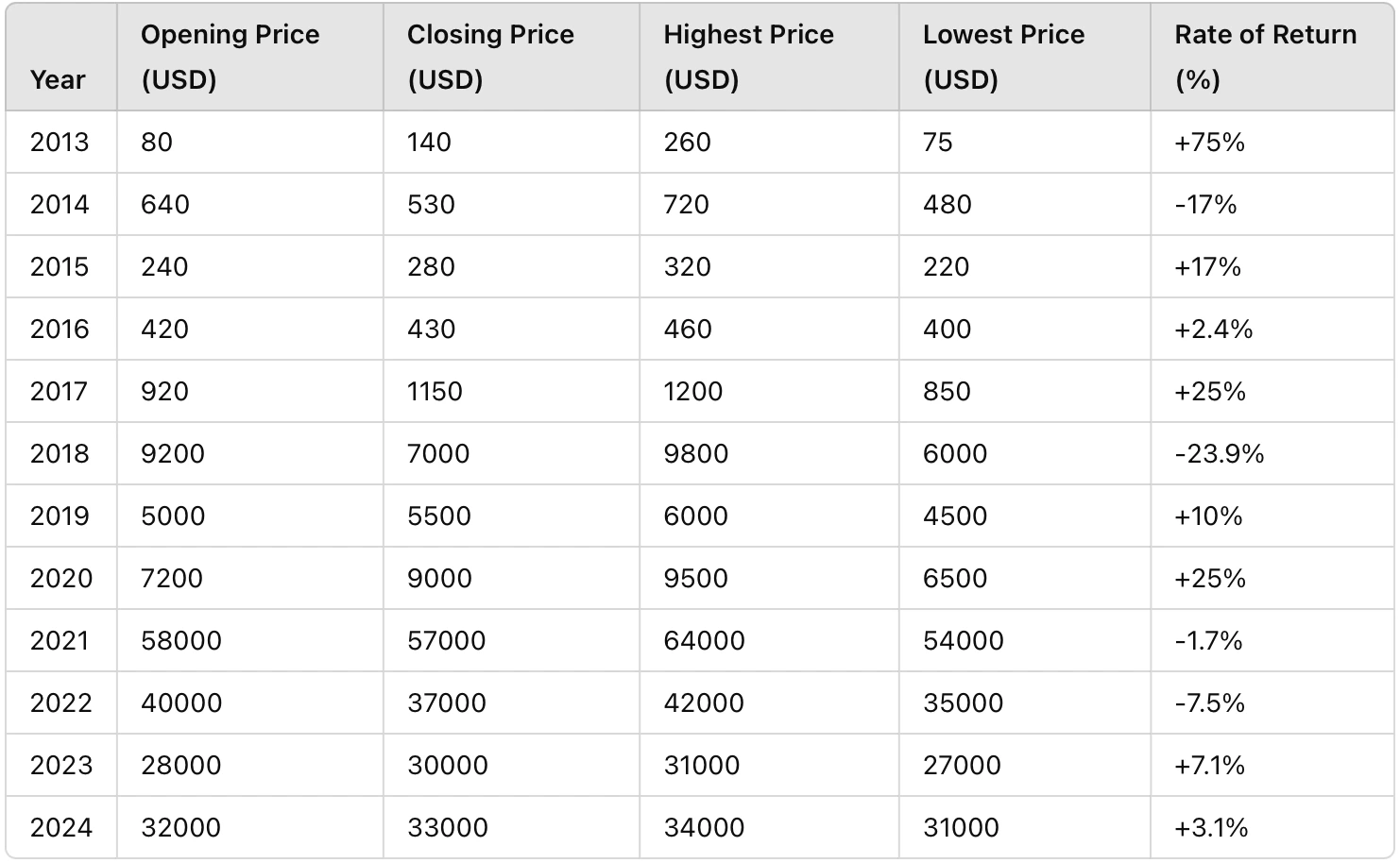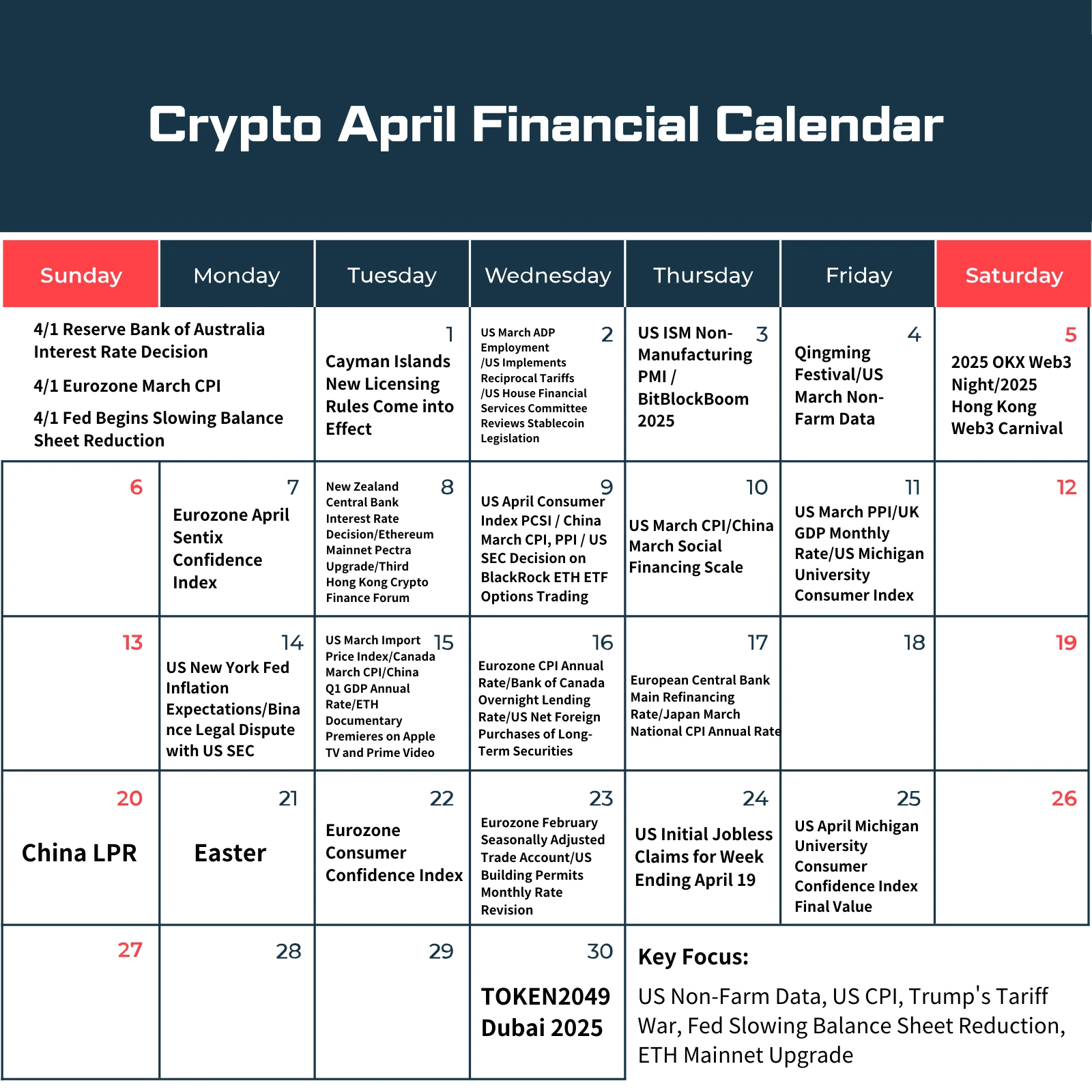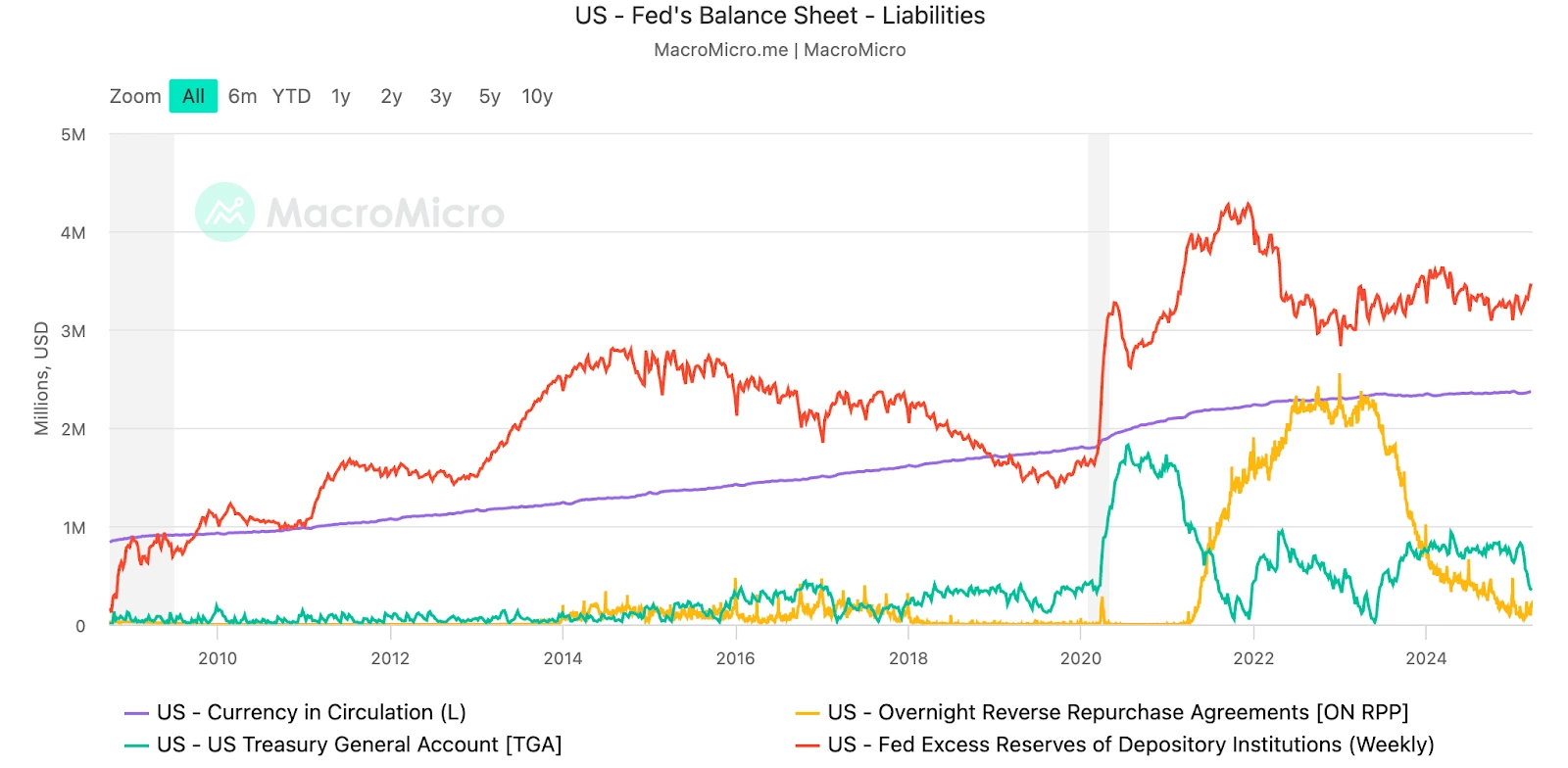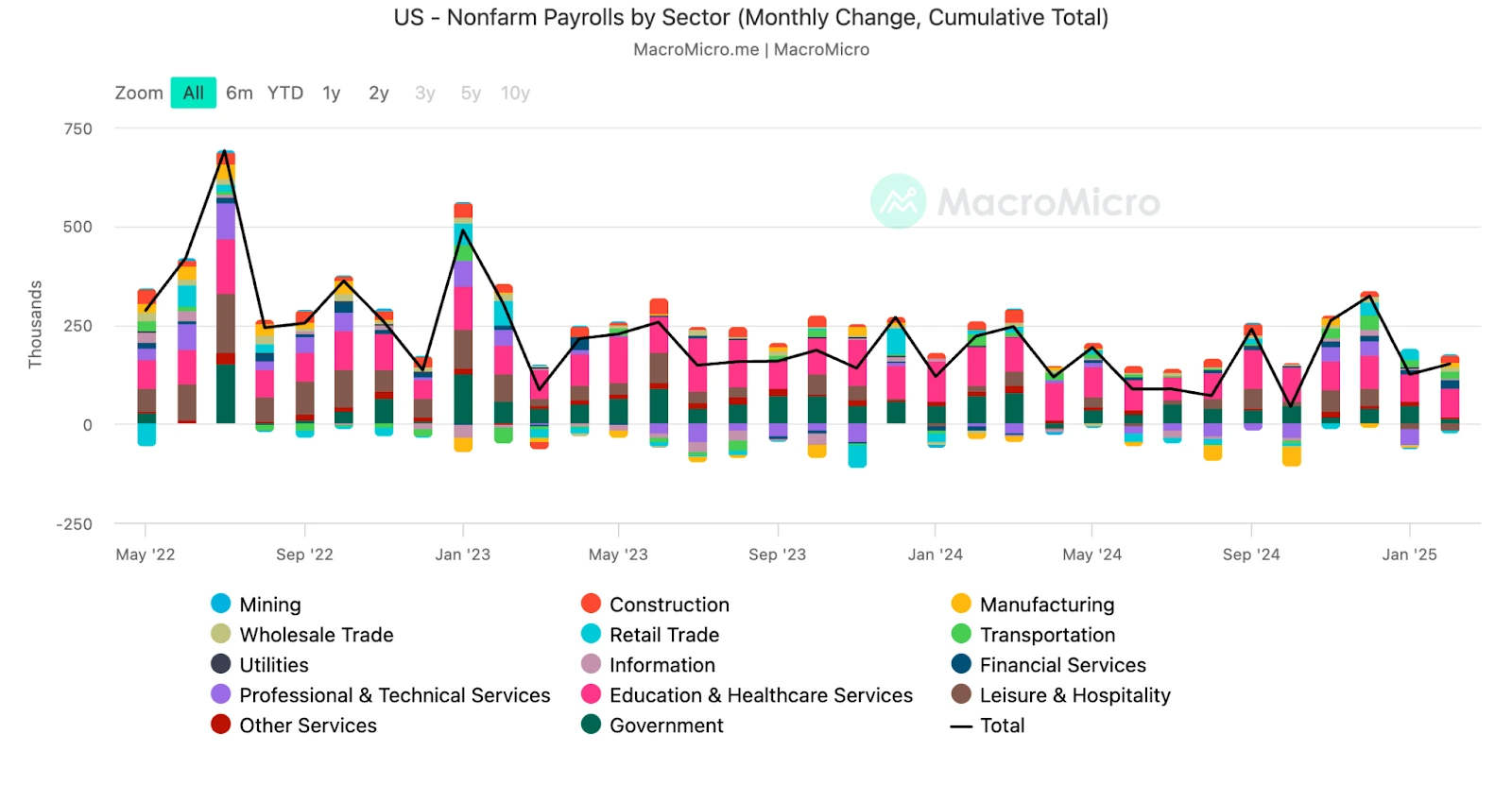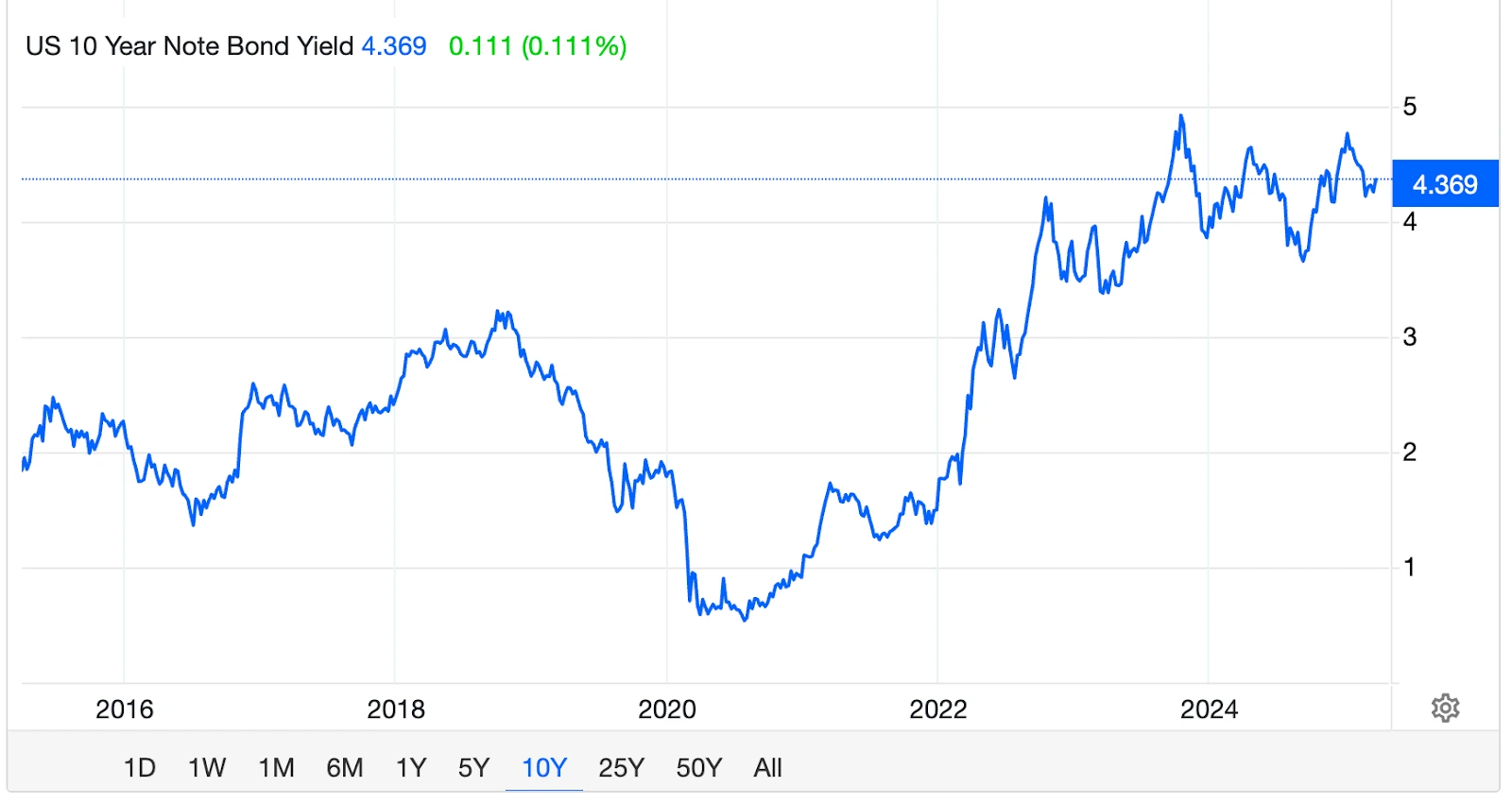
KEYTAKEAWAYS
- Fed's slower balance sheet reduction starting April 1 improves liquidity conditions, potentially supporting Bitcoin despite Trump's tariffs possibly stoking inflation concerns.
- Ethereum's Pectra upgrade on April 8 could catalyze price movement toward $3,000, following historical patterns where major upgrades boosted ETH prices.
- Market likely to remain in consolidation mode until mid-June's Fed meeting, with potential significant directional movement only after 14 weeks of bottoming.

CONTENT
April 2025 crypto market outlook: Analysis of Fed policy, Trump tariffs, ETH Pectra upgrade, and inflation data. Will Bitcoin’s historical April strength prevail despite limited catalysts? Market projections through June.
Compared to the bustling March, April seems much quieter. The Federal Reserve has no meetings, and central banks of major economies are also temporarily subdued. We’ll see more continuation of relevant policies, such as the implementation of Trump’s tariff policies and the Fed’s slowing of balance sheet reduction.
Historically, the second quarter, especially April, has traditionally been one of the best periods for risk assets like Bitcoin. April is considered a traditionally strong month for Bitcoin. According to market data, since 2023 in the current halving cycle, Bitcoin has experienced five corrections exceeding 20%, but each correction has been followed by stronger upward movements.
So, will the overall market in April continue to decline, stop falling and rebound, or even reverse and start rising?
HOW HAS BITCOIN PERFORMED IN APRIL HISTORICALLY?
Before the main content, let’s first review how Bitcoin, the bellwether of the crypto world, has performed in April historically. Below are statistics from third-party websites such as TradingView:
Historical Bitcoin Returns in April
(Source: CoinRank)
From the chart above, we can see that historically in April, Bitcoin has had more positive returns overall. Out of 12 years, the ratio of rises to falls is 8:4, indicating that upward trends have an absolute advantage. In the second year after the previous three halvings, i.e., 2013, 2017, and 2021, the rise-to-fall ratio was also 2:1. Overall, historical data shows that April is often a month of market sentiment adjustment and significant volatility for Bitcoin.
MAJOR EVENTS DIRECTLY AFFECTING THE ENTIRE CRYPTO MARKET
Crypto Financial Calendar for April
Key Focus: US Non-Farm Data, US CPI, Trump’s Tariff War, Fed Slowing Balance Sheet Reduction, ETH Mainnet Upgrade
Note: Black text indicates traditional financial events, red text indicates crypto events
April 1, Fed Begins Slowing Balance Sheet Reduction
The March Fed FOMC statement indicated that the Federal Reserve will begin slowing the pace of balance sheet reduction on April 1. The Fed will reduce the cap on Treasury securities redemptions from $25 billion/month to $5 billion/month, while maintaining the cap on MBS redemptions at $35 billion/month.
This is positive for the market because the direct impact of slowing balance sheet reduction is improved liquidity expectations. Slowing the reduction means reducing the speed at which liquidity is withdrawn from the market, equivalent to indirectly injecting more funds into the market. Historical experience shows that improved liquidity environments typically benefit risk assets like Bitcoin. This adjustment is interpreted by the market as a preventive measure by the Fed to avoid debt ceiling issues and potential economic pressures, potentially easing tight money market liquidity.
However, this positive factor may be partially offset by other macroeconomic factors (such as tariff policies), as Trump’s tariff policies could cause inflation. There’s a contradiction between inflation and rate cut expectations as the Fed maintains its forecast of two rate cuts (50 basis points) in 2025, but internal divisions among officials have intensified (fewer officials supporting cuts, more opposing). Meanwhile, core inflation expectations have been revised upward (2025 core PCE expectations raised from 2.5% to 2.8%), coupled with Trump’s tariff policies potentially pushing up import costs, inflationary pressures may limit the Fed’s room for rate cuts. If inflation remains persistently high, Bitcoin may face significant volatility.
Fed Liability Structure
(Source: MacroMicro)
In the short term, the Fed’s slowing of balance sheet reduction coupled with rate cut expectations may drive Bitcoin to maintain an upward trend with fluctuations in April, but caution is needed regarding risks of correction triggered by inflation data exceeding expectations or geopolitical conflicts. In the medium to long term, if the US economy achieves a soft landing (avoiding recession) and inflation is controllable, cryptocurrencies may benefit from improved liquidity; if stagflation risks intensify, market volatility will significantly increase.
Subsequently, it’s important to closely monitor US inflation data after the April tariff policy implementation, the Fed’s June interest rate decision statements on the rate cut path, Bitcoin ETF fund inflows, and on-chain activity indicators (such as exchange reserves, large transaction frequency), etc. Overall, the crypto world may show a “liquidity-driven” relatively strong fluctuation in the short term, but caution is needed regarding periodic corrections brought by macroeconomic uncertainties.
April 2, US Imposes Tariffs on Other Countries
The “reciprocal tariffs” policy (i.e., imposing tariffs at the same level as trade partners impose on the US) to be implemented by the US on April 2 may have complex effects on the cryptocurrency market.
Trump administration’s tariff policies may exacerbate US inflation by increasing imported goods prices and reshaping global supply chains. According to calculations, if the general tariff rate reaches 15% or above, US core PCE inflation could rise to 3%, far exceeding the Fed’s 2.5% target. This will limit the Fed’s room for rate cuts, and may even force the Fed to maintain high rates longer, thereby suppressing the liquidity environment in the crypto world. But the contradiction is: if tariffs lead to increased recession risks, the Fed may be forced to cut rates earlier, and liquidity easing expectations may temporarily support the crypto market.
After the April tariff policy is implemented, the optimistic scenario is that Trump’s tariff policy doesn’t trigger large-scale trade retaliation, and the Fed releases dovish signals (such as hints at rate cuts), BTC could break through the $90,000 resistance level and test the $100,000 mark; but the pessimistic scenario is, if tariff conflicts escalate and PCE data exceeds expectations, BTC may test the $75,000-$80,000 support range, and the altcoin market may accelerate its collapse.
Whether it’s pessimistic or optimistic depends on key data and event nodes at that time, such as April 2 tariff details, which need clarity on the scope of taxation, rates, and exemption clauses. If the policy is “more bark than bite,” the market may quickly digest the negative news; and April PCE inflation data: if core PCE continues to be above 2.8%, it may strengthen the Fed’s hawkish stance, suppressing the crypto market; specific data to watch includes Bitcoin ETF fund flows, institutional fund movements (such as BlackRock’s continued buying/selling) are important indicators for measuring market confidence.
The impact of the April 2 tariff policy on the crypto world depends on the triangular game of inflation-liquidity-market sentiment. Short-term markets may show intense fluctuations, but medium to long-term trends need to observe whether the US economy falls into stagflation and the policy coordination of global central banks. Investors need to adjust strategies flexibly and grasp structural opportunities amid uncertainty.
April 4, US March Non-Farm Data Released
US February non-farm payrolls added 151,000 jobs, with the unemployment rate slightly rising to 4.1%. After the data release, Bitcoin led the decline and hit new lows, mainly because there was a Fed interest rate meeting in March, which directly impacted the meeting, almost ensuring the Fed would not cut rates.
This time, the non-farm data release is still far from the next Fed interest rate meeting (May 6-7), so as long as the data doesn’t show significant anomalies, the impact on crypto market trends will be limited.
US – Nonfarm Payrolls by Sector (Monthly Change)
(Source: MacroMicro)
If March data is strong, it may intensify market concerns about the Fed maintaining “higher for longer” rates, the dollar index may strengthen further, suppressing Bitcoin prices; conversely, weak data may boost rate cut expectations, benefiting the crypto market. Currently, the Fed has slowed balance sheet reduction (reducing the Treasury redemption cap to $5 billion/month starting April), the marginal improvement in liquidity may form a tug-of-war with non-farm data.
The optimistic scenario is weak or as-expected data, i.e., new job additions ≤150,000, unemployment rate ≥4.3%, wage growth slowing. Rate cut expectations rise, dollar retreats, BTC may break through resistance levels and strengthen with fluctuations.
The pessimistic scenario is strong data, i.e., new additions ≥200,000, unemployment rate ≤4.1%, wage growth rebounding. Rate cut expectations delayed, BTC may test support levels and weaken with fluctuations.
April 8, Ethereum Mainnet Pectra Upgrade
Ethereum’s Pectra upgrade is planned to go live on the mainnet around April 8, but the specific date may still be adjusted based on testnet evaluation results. The core goal of this upgrade is to enhance network performance through a series of Ethereum Improvement Proposals (EIPs).
The Pectra upgrade is Ethereum’s first major technical update in nearly 11 months, combining the “Prague” and “Electra” upgrade plans, mainly focusing on wallet experience optimization and validator mechanism reform. These improvements are believed to potentially attract more institutional and individual users, especially by lowering the staking threshold and enhancing wallet experience, directly benefiting Ethereum ecosystem adoption rates.
Short-term catalyst effect: Historically, major Ethereum upgrades often serve as catalysts for price increases. For example: after the Chaella upgrade in April 2023, ETH rose 45%; before the Dencun upgrade in March 2024, ETH gained 70%. If the Pectra mainnet upgrade goes smoothly, the market may speculate on the technical benefits in advance, driving ETH to continue rising and touching the $2,800-3,000 range.
However, overall, a favorable turn in the broader environment (such as Fed rate cuts and balance sheet expansion) is still needed; and recent events such as the Ethereum Foundation selling tokens and core developers leaving have caused community dissatisfaction, coupled with the rise of competitors like Solana, may weaken the positive impact of the upgrade. Although the testnet is progressing smoothly, if vulnerabilities or delays occur in the mainnet upgrade, it may trigger short-term selling pressure.
Additionally, it’s important to monitor the actual technical implementation effects, focusing on actual user experience improvements after the upgrade (such as reduced Gas fees, increased transaction speeds), Layer 2 scaling effects, etc. If internal personnel turmoil and governance disagreements within the Ethereum Foundation continue, it may also affect the efficiency of future upgrades.
In the short term (April-June), if the Pectra upgrade lands smoothly, ETH prices may rise with fluctuations due to technical benefits and increased staking demand, targeting around $3,000; but caution is needed regarding profit-taking resulting from the market “buying the rumor, selling the news.”
In the medium term (6-12 months), if ecosystem activity significantly increases after the upgrade (such as DeFi TVL growth, Layer 2 transaction volume doubling), ETH may start a new cycle; conversely, if competing public chains continue to squeeze market share, prices may face pressure.
April 10, US March CPI
US March CPI data is an important reference indicator for the Fed to adjust monetary policy. If CPI growth is higher than expected (especially core CPI), it may strengthen market expectations for the Fed to maintain high rates or delay rate cuts, leading to a stronger dollar, tighter liquidity, thereby suppressing prices of risk assets like Bitcoin.
US February CPI data was: year-on-year increase of 2.8%, core CPI year-on-year increase of 3.1%, persistently higher than the Fed’s target level. If this data is higher than expected (e.g., core CPI ≥2.8%), it may trigger market concerns about “stagflation,” the crypto market may experience short-term selling, Bitcoin may test key support levels, even touching a new low of $76,000.
If it meets or is lower than expected (e.g., core CPI ≤2.6%), it may boost rate cut expectations, driving funds into the crypto market, Bitcoin may break through the $90,000 resistance level, even testing the $100,000 mark.
Leverage and liquidation risk: The current leverage ratio in the cryptocurrency market is relatively high (perpetual contract funding rates have recently rebounded), if CPI data triggers violent price fluctuations, it may trigger large-scale liquidations. For example, after the February CPI data was released, Bitcoin’s trading volume surged 40% within 1 hour, with obvious panic selling. Additionally, tariff policy and inflation transmission: The automobile import tariffs (25%) implemented by the Trump administration on April 2 may push up US import costs, exacerbating imported inflation pressure. If March CPI data exceeds expectations as a result, the market may further worry about Fed policy tightening, putting pressure on crypto assets.
Before the data release, reduce high-leverage contract positions to avoid liquidation risks from extreme volatility; after the data release, if CPI is lower than expected, consider buying BTC/ETH on dips; if higher than expected, pay attention to the effectiveness of Bitcoin’s $80,000 support level, be cautious about chasing short positions.
April 16, US Net Foreign Purchases of Long-Term Securities
In the current high interest rate environment maintained by the Fed, the carry trade opportunities for long-term securities (such as US Treasuries) become more attractive, encouraging foreign investors to increase positions to lock in higher returns. Foreign investors tend to “buy long, sell short,” meaning increasing holdings of medium and long-term US bonds while reducing short-term securities. This strategy may reflect bets on the Fed’s future rate cut path: if rate cuts are delayed, long-term yields remain relatively stable; if rate cuts begin, long-term bond prices will benefit from declining rates.
If foreign investors shift toward long-term securities, it indicates market risk appetite contraction, contrasting with the high-risk asset characteristics of the crypto world. The increasing probability of US economic “no landing” (i.e., high growth and high inflation coexisting) may lead to marginal tightening of US dollar liquidity, further suppressing crypto world fund inflows. Additionally, if US Treasury yields climb, it will enhance the attractiveness of traditional financial assets, reducing crypto funds and intensifying downside risks.
US 10-Year Government Bond Yield
(Source: Trading Economics)
In summary, if the Fed maintains a hawkish stance, US Treasury yields may continue to rise, and the crypto world may face sustained selling pressure; conversely, if economic data weakens or geopolitical risks ease, funds may flow back to risk assets like cryptocurrencies.
April 30, TOKEN2049 Dubai 2025
TOKEN2049 Dubai will be held from April 30 to May 1, 2025. TOKEN2049 is a premier cryptocurrency event held annually in Dubai and Singapore, where founders and executives of leading Web3 companies and projects share their views on the industry.
TOKEN2049 brings together the global Web3 industry, gathering entrepreneurs, investors, developers, industry insiders, and global media, providing an opportunity for in-depth exchange across the entire crypto industry. It is held semi-annually in Dubai and Singapore.
Other Financial Events
- April 1: Reserve Bank of Australia interest rate decision; Eurozone March CPI; Cayman Islands crypto new regulations come into effect.
- April 2: US March ADP employment figures; US House Financial Services Committee reviews stablecoin legislation.
- April 8: New Zealand Central Bank interest rate decision; Third Hong Kong Crypto Finance Forum.
- April 9: US SEC decision on BlackRock ETH ETF options trading April 10: US New York Fed 1-year inflation expectations for February.
- April 11: US March PPI; UK GDP monthly rate; US Michigan University consumer index.
- April 14: US New York Fed inflation expectations; Binance and US SEC legal dispute.
- April 15: US March import price index; China Q1 GDP annual rate; ETH documentary premieres on Apple TV and Prime Video.
- April 16: Eurozone CPI annual rate; Bank of Canada overnight lending rate.
- April 17: European Central Bank main refinancing rate; Japan March national CPI annual rate.
Additionally, attention should be paid to token unlocks for some projects, such as: SOL, SAGA, APT, TRUMP, DYDX, SUI, etc.
- SOL: Solana will unlock 637,000 SOL between April 7-11, currently worth approximately $80.49 million, accounting for 0.12% of its total market value.
- SAGA: Saga will unlock tokens worth approximately $300 million in April.
- APT: Aptos will unlock $300 million worth of tokens in April.
- TRUMP: Trump tokens will unlock in April.
- DYDX: DYDX will unlock approximately 33.33 million tokens on April 1, worth about $115 million.
- SUI: Sui will unlock 34.62 million tokens on April 3, worth about $67 million. These token unlocks will have a certain impact on the market, and investors need to closely monitor the dynamics of relevant projects and market reactions.
Finally, all the above views are just one perspective, more importantly providing a channel for everyone to explore, to listen to different opinions for clarity, and deeply understand the logic behind events, thereby forming your own judgment.
CONCLUSION
Bitcoin’s weekly line has rebounded with volume contraction for 2 consecutive weeks. From a technical perspective, the weekly line is currently touching the lower Bollinger Band (usually an oversold signal), short-term selling pressure exhaustion has triggered short covering and technical bottom fishing, but the shrinking trading volume indicates that major funds have not massively intervened, just existing funds gaming; the weekly MACD death cross and expanding green histogram (bearish momentum) indicate that the medium to long-term trend remains bearish, and the short-term rebound may just be a continuation of the decline.
Looking at a longer timeframe, BTC underwent nearly 14 weeks of consolidation at high levels before breaking down with increased volume. If there is no fundamental change in the environment, such as the Fed accelerating rate cuts, then the bottoming time should not be less than the high-level consolidation time, and may even be longer.
By this calculation, the possibility of successful bottoming and complete trend reversal will be greater by the time of the Fed’s fourth interest rate meeting this year on June 19 (market mainstream expectation is that the first rate cut this year will occur).
Before mid-June, there won’t be much market action, with a high probability of range-bound fluctuations to form a bottom. April’s market may first decline, then fluctuate and rebound. For the next two months or more, don’t have expectations of getting rich quickly; take profits when possible, securing gains is the best strategy!












